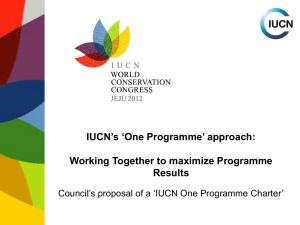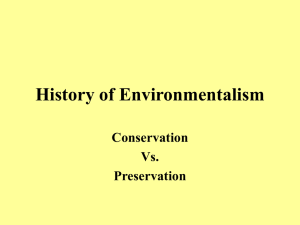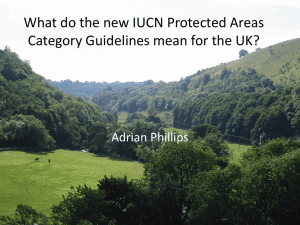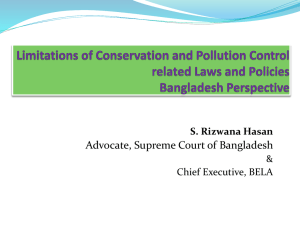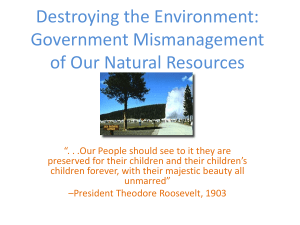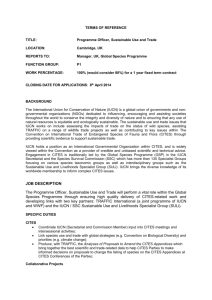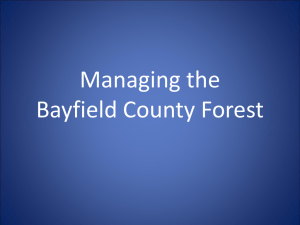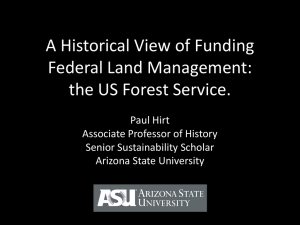FLEG and FLEG-T
advertisement
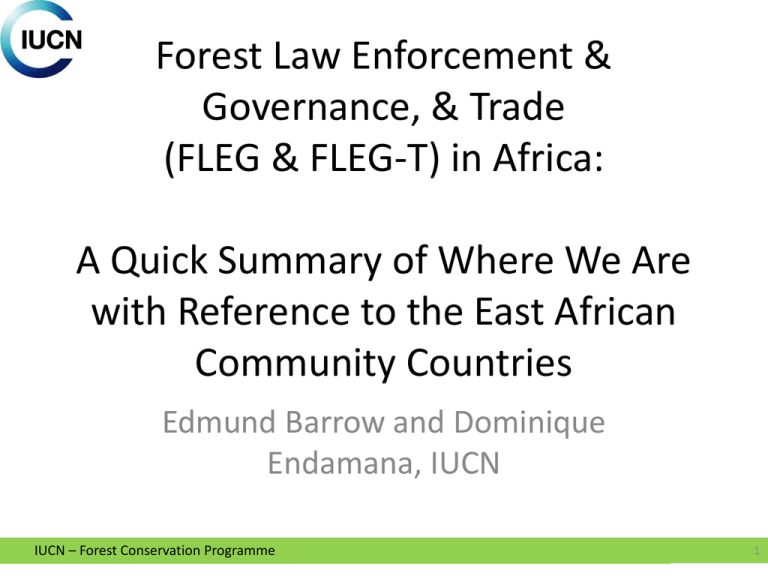
Forest Law Enforcement & Governance, & Trade (FLEG & FLEG-T) in Africa: A Quick Summary of Where We Are with Reference to the East African Community Countries Edmund Barrow and Dominique Endamana, IUCN IUCN – Forest Conservation Programme 1 Context • Globally $10 to $15 billion lost annually by governments of timber producing countries due to illegal logging & undervaluation • Up to 80 – 90% of logging maybe illegal, e.g. Cameroon loses $195 million p.a., $58 million p.a. in Tanzania • Why: – Land clearance for agriculture – Excessive commercial logging – Weak governance (corruption, inequitable policy & institutional arrangements) • Yaoundé set roadmap for national & sub-regional action (But has there been action since?) IUCN – Forest Conservation Programme 2 What are We doing on Forest Governance in Africa??? • Yaoundé Ministerial Declaration 2003: • 1998 – G8 countries agree to share information on illegally traded timber, & Africa learnt from Asia process (2001) & included Civil Society participation • IUCN facilitated 7 regional civil society consultations in 2003 to prepare for the conference (West, Eastern, Central & Southern Africa) – over 70 NGO’s involved • Yaoundé Declaration adopted (by declaration) by the 31 countries present - & set a road map for future work in Africa • Ghana agreed to pilot declaration in practice IUCN – Forest Conservation Programme 3 Progress in Africa • Ghana taking a lead in FLEG - 1st VPA (Voluntary Partnership Agreement) signed with EU on 3/9/08; similar process initiated in Liberia – Governments, Civil Society. • Central Africa – FLEG in process in Cameroon, DRC, Congo Brazzaville (EC funded IUCN in DRC) • China tour to Africa (Gabon, Ghana & DRC) – 2008 (IUCN & DfID) • TRAFFIC scoping study on timber flows in eastern, central & southern Africa; similar study in west Africa (DfID) • EAC country FLEG process initiated • Increasing bi-lateral (DfID, Finland), & Multi-lateral (EU, WB) support IUCN – Forest Conservation Programme 4 East African Countries – FLEG Process • This process – 5 national studies (each member state – Bu, Ke, Rw, Tz & Ug), 5 countries completed roundtables (4 per country - private sector, civil society, government, & joint) • Partnership – EAC, 5 member states, with support from Finland, IUCN, Africa Forest Network (AFORNET), Africa Forest Forum (AFF), & World Bank • Informed by Yaoundé Declaration. IUCN – Forest Conservation Programme 5 FLEG & FLEG-T • Not just about forests but about • Sustainable forest management & legal trade • Equity & fair sharing of benefits • Recognizing value of forests to people, districts & national accounts • Managing & controlling illegalities • Not just “Forest” issues – but about security, revenues, customs, accounting & about economic growth + poverty reduction, & • Now it is also about climate change & REDD IUCN – Forest Conservation Programme 6 Lets look at some of the timber flows that are happening, many of which are illegal IUCN – Forest Conservation Programme 7 Timber Flows in & from DRC Fig.1: Flux of timbers & wood products within DRC, to neighbouring countries; & to other continents such as EU, ASIA & USA ( very important & legal; very important & illegal; & less important & illegal). IUCN – Forest Conservation Programme 8 Timber Flows in Eastern, Central and Southern A. Africa Charcoal to Gulf States 40% 60% Teak from S-Sudan to Ug & Ke From Mz to Ke To China (especially) 90% To S. Africa IUCN – Forest Conservation Programme Africa accounts for 4.9% of China’s timber! 9 Some Issues (So far) • Inaccurate, insufficient & conflicting information on trade; • Informal, or illegal trade holds a large market share – often due to simplicity of license systems & lack of checks; • Insufficient political buy-in & support for local-level action (local rights, community based forest management); • Under-valuation, under-declaration & low collection of revenues – concessions poorly monitored; • Frequent intervention & collusion of elites/leadership to override legislation & allow unsustainable & illegal practices; • Unable to determine origin & legality of timber, both in-country & intra-regionally – lack of certification & independent monitoring; • Timber trade policy export-driven & subject to global market trends & volatility. IUCN – Forest Conservation Programme 10 Besides Timber what else flows?? • Medicinal plant extracts (e.g. Prunus africana), honey, Gum Arabic, bamboo, rattan, paper - Over 50 important species; • Wood for other purposes - furniture, carvings, barbeques; • Bush meat – especially with opening up of logging routes; • Elephant tusks – poaching (opening of routes) & illegal trade (esp. from central Africa); • Also other animals – e.g. Bonobo, mountain & lowland Gorilla, Okapi, Rhino – logging routes open up the forest for such trade. Strong linkages between illegal timber & wildlife product trade. IUCN – Forest Conservation Programme 11 Potential Linkages: Timber & Wildlife Products • Such trade – both contentious, political, & fraught with power/corruption; • How can the 2 sectors support each other & work more closely (without making things too complex)? • Where are the entry points (geography, thematic, supply/demand)? • Where & how does this happen functionally?? IUCN – Forest Conservation Programme 12 What are we learning? • Losses huge & equate to significant % of ODA • Need real action not more words • Opportunities (some): – Get political commitment (make case, Parl. committees) – Recognize importance of forests in national accounts, economies (& not just timber) – PRSPs, livelihoods – Implement incentives – pricing, markets (& processing), & remove barriers (“red tape”) – Implement subsidiarity – PFM & local rights & responsibilities key – Gov. law enforcement can never be enough – Promote enabling environment – the Gov role – policy support, promote incentives, remove barriers. – Make alliances as it is more than forests – other agencies have their roles (revenue, security, customs) IUCN – Forest Conservation Programme 13 Some Conclusions • Illegal trade & under-valuation has very large impacts – revenue losses, degradation, loss of livelihoods for rural poor • Complex to address – requires engagement at different levels (local, national, regional, international), and sectors (forests, security, trade, revenue, customs, political) • At national levels requires a MSD type process – to engage with government, civil society and the private sector • Action at national levels (policy, law, implementation), with Regional Economic Commission coordinating support (regional policy implementation IUCN – Forest Conservation Programme 14
